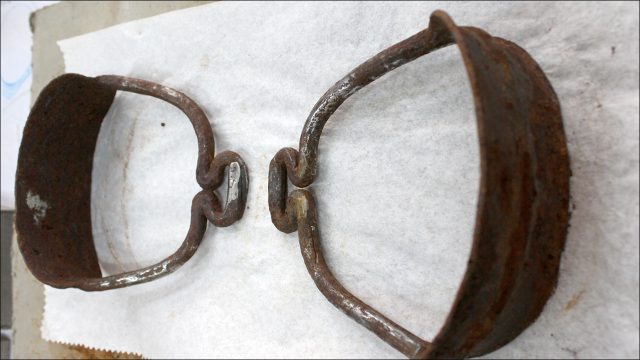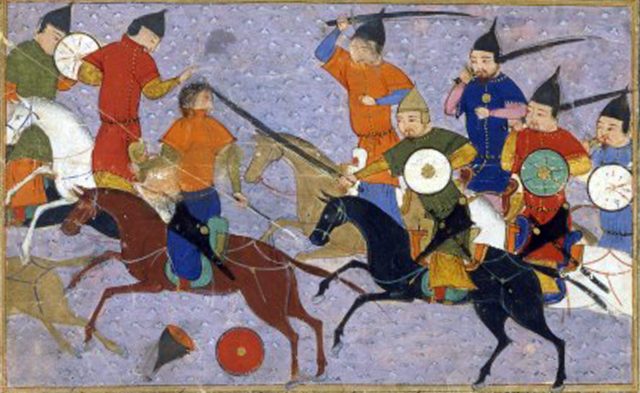The humble stirrup was a game-changing invention that altered history.
When a man named Temüjin was given the title of Genghis Khan in 1206, the Mongols were a recently united people, tucked away in the northeast corner of Asia. By the time Genghis Khan died in 1227, they were sunning themselves on the shores of both the Pacific Ocean and the Caspian Sea. By 1241 they were knocking at Vienna's door, and they remained the terror of eastern Europe for the rest of the century. The Mongols claimed the largest consolidated land empire in history. Seemingly the only way to keep them out was to put the Himalayas between you and them. And many historians believe their power stemmed from an incredibly simple technological innovation: the stirrup.
No one knows when the stirrup was first invented, but it was a boon to any military that used it. Even the simplest of stirrups, a leather loop, let mounted soldiers ride longer distances and stay mounted on their horses during battle. The military success of the forebears of the Cossacks is often attributed to two loops of leather. Same with the Goths and the Huns. Some believe the stirrup even shifted the balance of power in Europe from foot soldiers to mounted knights, dubbed the "armored tanks" of the medieval world by historian Roman Johann Jarymowycz.
The Mongols took things further. Historians think they not only had leather stirrups, but metal ones as well. In 2016, archaeologists at the Center of Cultural Heritage of Mongolia unearthed the remains of a Mongolian woman dating back to the 10th century AD. Along with sturdy leather boots and some changes of clothes, she was buried with a saddle and metal stirrups described as in such good condition that they could still be used today. The stirrups are one continuous thick piece of metal with an open loop for a saddle strap on the top and a wide, flattened, and slightly rounded foot rest. The stirrups had to be comfortable and tough, because Mongols used them to ride in a way no one else rode.

Enlarge / This pair of 1,100-year-old metal stirrups was unearthed from a Mongolian woman's grave in 2016. They were part of a well-preserved saddle with reinforcements that would have allowed the rider unprecedented mobility.
The Center of Cultural Heritage of Mongolia.
A general of the Song Dynasty (960-1279) described the Mongols riding long distances standing up in the saddle, with "the main weight of the body upon the calves or lower part of the leg with some weight upon the feet and ankles." The stirrups were meant to keep the rider centered and upright in even the most tumultuous situation. They hung from a saddle that was made of wood and had a high back and front. These, supplemented with endless hours of practice, gave a Mongol rider unprecedented stability. The rider could maintain hands-free balance on the horse while the horse twisted and turned and while the rider himself turned in the saddle. A fluidly mobile rider could then use his hands to fire arrows in any direction as he rode.
At a time when most armies won by driving ineluctably forward, the Mongols advanced and retreated while never letting up on their assault. When they met their opposition, their cavalry galloped forward with wild agility, shooting arrows continuously, presenting a terrifying united front. As they got within a few yards of the other army, the charging horsemen's unity broke. They turned and galloped away as quickly as they'd come.
The power of retreat
Historian Thomas Craughwell explains that an ability to twist in their saddles meant that, even as the Mongols rode away, they could shoot arrows back toward the enemy army. As the army continued to charge and retreat, their patterns became ever more chaotic. Marco Polo, who saw the Mongols in action, described their technique: "They never let themselves get into a regular melee, but keep perpetually riding around and shooting into the enemy."
If traditional mounted troops were like tanks, Mongol-mounted warriors were fighter pilots. Their mastery of movement made them unbeatable. The other army would advance on a shifting, uniting, scattering, and reuniting foe.

Enlarge / This is a representation of a battle between Mongols and the Chinese, recorded in 1211 in the Jami' al-tawarikh, by Rashid al-Din. Note the Mongols standing in their saddles.
When all else failed, the Mongols used psychology. At a signal, the cavalry could wheel around and make a convincingly jumbled false retreat. Unwary opposition forces would often then charge after them, believing that the battle had, unexpectedly, gone their way. The Mongol cavalry would then turn right back around, having lured a few overconfident souls too close. More often, though, they would continue their retreat and then maneuver out of the way. Then, unmounted archers would shower the pursuing army with arrows, and more heavily armored cavalry could charge in with lances. At that point, the battle was as good as over.
The Mongolian Empire's stunning rise to power reveals how one technological development provided a literal stepping point for a new style of warfare—one that could not be resisted by any existing army. The largest land empire the world has ever known did not exist because of any one factor. A thousand different circumstances helped Genghis Khan and his immediate descendants conquer most of a continent. But the stirrup played an indispensable role. Engineering the perfect stirrup gave an army, and a people, an ineradicable place in history.

No comments:
Post a Comment